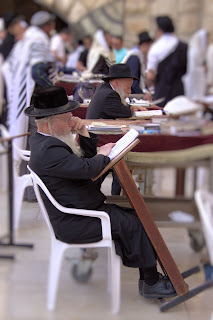The Western Wall, also know as the Wailing Wall, or the Kotel; is one of the most sacred sites in all of Judaism. It is actually a part of the retaining wall of the Temple Mount, built by Herod the Great between 19 BCE and 4 BCE. The wall is on what was the west side of the Temple Mount and is believed to be the closest wall to the Holy of Holies, when the second Temple was on top of the mount.
In Judaism, the Western Wall is revered as the sole remnant of the Temple. It has become a place of pilgrimage for Jews, as it is the closest permitted accessible site to the holiest spot in Judaism, the Foundation Stone, which is located on the Temple Mount (inside the Dome of the Rock).
You can see Jews praying at the wall each day, as well as many Christians. Many write prayers on slips of paper and insert them into the cracks of the walls. Since I have returned from our trip, many have asked what impressed me the most about Israel. I have to say it was the Western Wall. To see people standing with their face to the wall, intently focused, was very moving. While many may see this as legalistic, I only saw honest, and devoted, worshipers of the Lord. I found it difficult to take pictures here, not because it was not allowed, it is allowed. But I felt almost as if I was intruding on someone's personal conversation with the Lord. I'm thankful that with a telephoto lens I could stand in the background, and was hopefully as unobtrusive as possible.
 |
| This is a scale model of the Old City of Jerusalem, and Second Temple, that is on the grounds of the Israel Museum. The arrow pointing to the Western Wall actually points at the location on the wall where Jews pray today, and where these photos were taken. You can understand from its proximity to the backside of the Temple (and therefore the Holy of Holies) why this spot is sacred to Judaism. |

























No comments:
Post a Comment